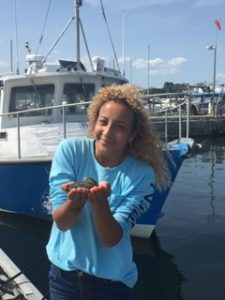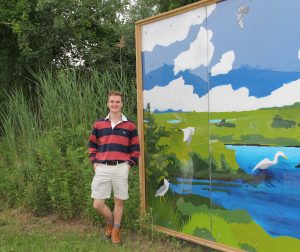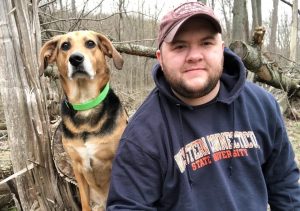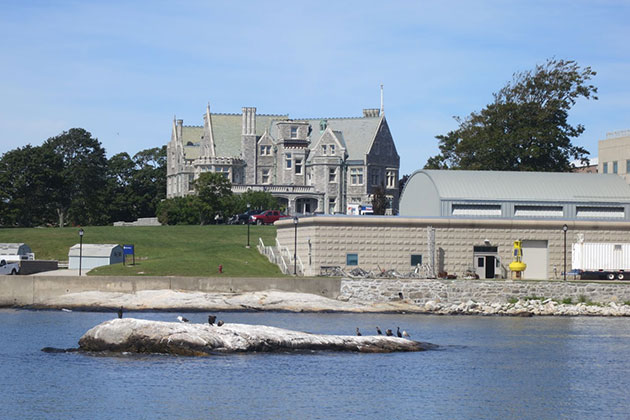Three undergraduate students helping pave the way for greater diversity in the sciences have been chosen as the first recipients of Connecticut Sea Grant’s new summer undergraduate research fellowships for underrepresented and underserved students in marine and coastal scientific research.
UConn students Andrew Tienken ’22 (CLAS) and Larissa Tabb ’22 (CLAS) and Western Connecticut State University (WCSU) student James Hannon each will receive a $5,000 stipend to conduct summer research projects under the guidance of a faculty mentor.
“We are pleased to support more students in their pursuit of a career in the sciences and look forward to learning about the outcomes of their individual projects,” says Nancy Balcom, associate director of CT Sea Grant.

The program is designed to provide early career experience, training, and mentorship to underrepresented minorities and socioeconomically disadvantaged students as well as students of color, indigenous students, members of the LGBTQ community, and students with disabilities.
“This fellowship is the result of several years of visioning efforts that I was involved in within the National Sea Grant program which focused on enhancing diversity, equity and inclusion,” says Syma Ebbin, who led the creation of the program as CT Sea Grant’s research coordinator “Funding was made available from the National Sea Grant program for state programs to push this visioning agenda forward. The motivating idea is that in order to have greater diversity in marine and coastal sciences, more efforts are needed to engage and mentor students earlier on in their academic careers. This effort is being made to prime the pipeline, so to speak, so in the future there will be a greater diversity of highly trained individuals working in marine research.“
Tienken, Hannon, and Tabb, who are all rising juniors majoring in environmental science, biology, and marine science, respectively, say they are grateful for the support Connecticut Sea Grant is providing to help increase diversity in their fields of interest.
“There aren’t that many minorities in marine science, and I want to be an inspiration and help to change that,” says Tabb, a 19-year-old New Britain resident who is African American.
Tienken and Hannon shared similar experiences of being one of very few students in their programs identifying with the LGBTQ community. The fellowship gives them the chance to advance their prospects for future success and longevity in their fields, ultimately serving as role models for future students.
“It’s a really, really wonderful opportunity,” says Hannon, a 27-year-old Danbury resident.
Due to restrictions on undergraduate field research due to the COVID-19 pandemic, Tabb and Hannon will defer beginning their projects until the summer of 2021. Tienken, however, worked with his faculty advisor, Beth Lawrence, an assistant professor in the Department of Natural Resources & the Environment, to revise his original plan for field research into a data analysis project he is doing from his home in Wilton. He is using data collected by Lawrence and her research team in 2017 from 20 wetland sites along the Connecticut coast to quantify the services of phragmites, an invasive plant that nonetheless appears to outperform native grasses at removing excess carbon and nitrogen from the environment. He will also assess the carbon and nitrogen removal functions of native grasses.

“I’ve been wanting to do this work for some time,” says Lawrence. “It was just waiting for the right student and opportunity to come along.”
Tienken says the project required him to learn how to use ArcGIS software to combine data from individual marshes with marsh maps and determine which areas are colonized primarily by phragmites and which by native grasses. Restored and unrestored marshes are being compared. Both he and Lawrence hope the work will ultimately contribute to a better understanding of the important services of wetlands and how they should best be managed and preserved, especially in light of climate change.
“I’ve been fascinated by how efficient wetlands are at sequestering carbon,” Tienken says. “These are efficient and powerful ecosystems.”
For his project, Hannon, working with WCSU professor Michelle Monette, will be collecting Atlantic killifish from Long Island Sound and placing them in tanks in labs at WCSU with water at various temperatures and salinities. After exposure, tissue samples from the fish will be extracted and examined to determine how various conditions impact these important forage fish, also called mummichog. The different temperatures and salinities will mimic how marine waters could change due to climate change. Hannon says the project could help answer an important question about the future fate of killifish.

“As these fish are being pushed to their thermal limits, are they going to be overwhelmed by rising water temperatures and maybe not able to survive?” he asks.
Tabb, for her project, will be working with Evan Ward, professor and head of the Department of Marine Sciences, to study whether types of plastic that are labeled as biodegradable actually break down when exposed to water and soil, and whether microbes are consuming them. These will be compared with the fate of plastics not identified as biodegradable that will also be exposed to water and soil.
Having worked on other research projects involving plastics in Ward’s lab at UConn Avery Point, Tabb is very aware that plastics are a major issue in the marine environment and a critical area of research.
“Seeing the effects of plastics on the oceans is so concerning,” she says. “I’m glad to be part of any effort we can make to learn more about it.”
Lawrence says the new fellowship program will not only benefit these three students, but also the quality of the science and research they are involved in.
“It’s great that Connecticut Sea Grant is promoting diversity in the sciences,” she says. “We need scientists from different backgrounds to ask better questions. We need a diversity of perspectives.”
For information about the program, visit: https://seagrant.uconn.edu/funding/fellowships/.



